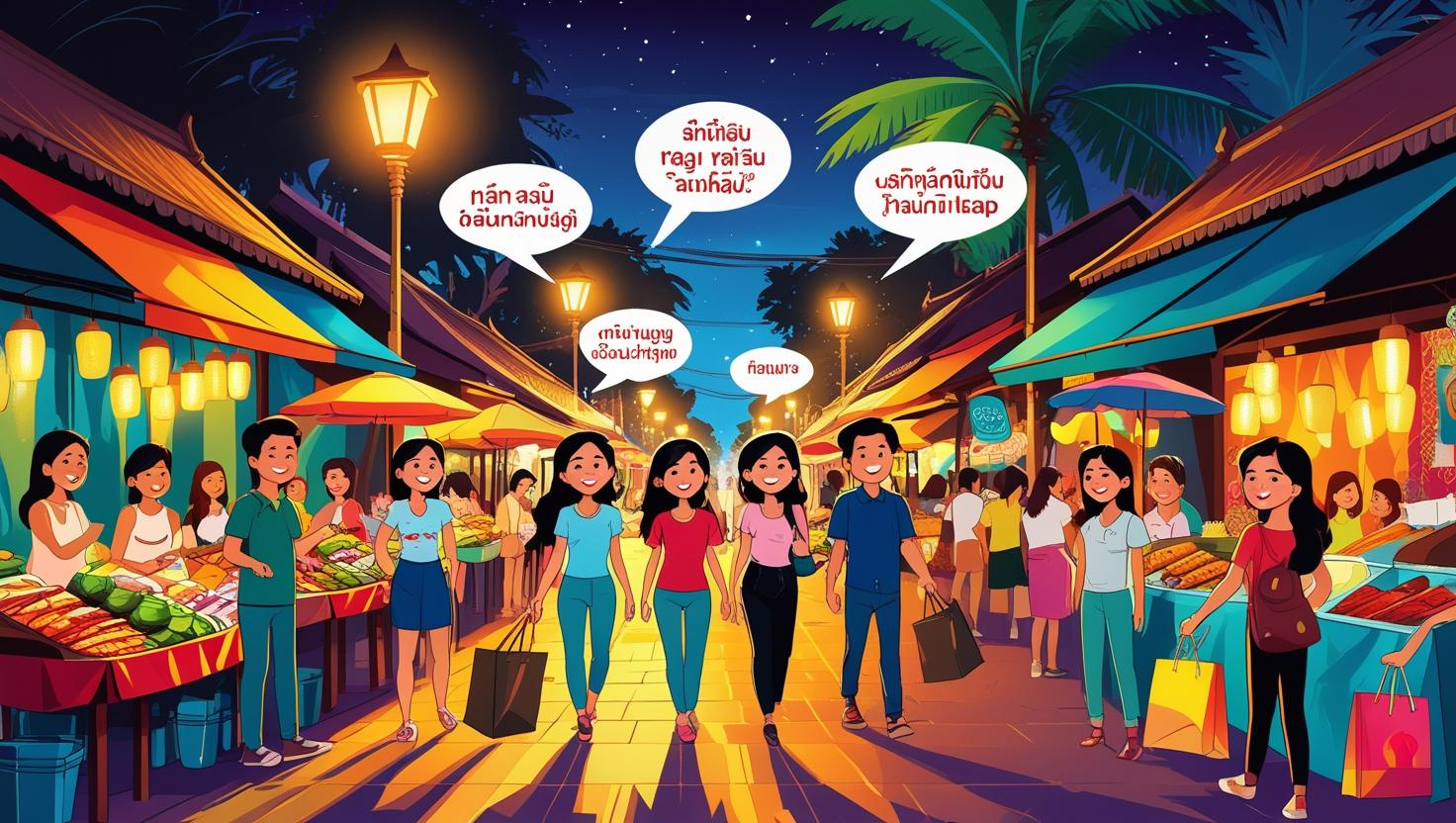Are you planning a trip to Thailand or just want to practice your Thai language skills in real-life situations? One of the best ways to experience Thai culture is by visiting a bustling walking street—also known as a night market—where you can shop, eat, and mingle with locals.
In this post, you’ll learn essential Thai phrases and sample dialogues you can use when exploring a lively walking street. Each dialog is written in both Thai and English, with pronunciation guides, grammar tips, and quick tests to help you practice.
🎯 Why Learn Thai for Walking Streets?
Thailand’s walking streets are packed with food stalls, souvenirs, live music, and friendly people. Speaking even basic Thai can make your experience more fun, help you connect with locals, and sometimes even get you better prices!
🛍️ Sample Dialog 1: Shopping for Souvenirs
สถานการณ์ (Situation): You want to buy a souvenir at a stall.
Thai Dialog:
A: สวัสดีค่ะ/ครับ ร้านนี้ขายอะไรบ้างคะ/ครับ
Sà-wàt-dee kâ/khráp. Ráan née kăai à-rai bâang ká/khráp?
(Hello! What do you sell here?)
B: สวัสดีค่ะ/ครับ เรามีของฝาก เสื้อผ้า และของที่ระลึกค่ะ/ครับ
Sà-wàt-dee kâ/khráp. Rao mee kŏng fàak, sêua pâa, láe kŏng tîi rá-lʉ́ʉk kâ/khráp.
(Hello! We have souvenirs, clothes, and gifts.)
A: อันนี้ราคาเท่าไหร่คะ/ครับ
An née raa-khaa tâo-rài ká/khráp?
(How much is this?)
B: อันนั้น 150 บาทค่ะ/ครับ
An nán nèung-rói hâa-sìp bàat kâ/khráp.
(That one is 150 Baht.)
📝 Grammar Tip:
-
ค่ะ/ครับ is used at the end of sentences for politeness.
-
The word เท่าไหร่ means “how much.”
✅ Practice Question:
How do you say: How much is this? → อันนี้ราคาเท่าไหร่คะ/ครับ
🍢 Sample Dialog 2: Ordering Street Food
สถานการณ์ (Situation): You’re ordering snacks from a food vendor.
Thai Dialog:
A: ขอหมูปิ้ง 3 ไม้ กับข้าวเหนียว 1 ห่อค่ะ/ครับ
Khŏr mǔu pîng săam mái gàp khâao nĭaw nèung hòr kâ/khráp.
(I’d like 3 pork skewers and 1 sticky rice, please.)
B: ได้ค่ะ/ครับ ทั้งหมด 50 บาทค่ะ/ครับ
Dâai kâ/khráp. Tháng-mòt hâa-sìp bàat kâ/khráp.
(Sure! That’s 50 Baht in total.)
A: รับน้ำด้วยค่ะ/ครับ น้ำอะไรแนะนำบ้างคะ/ครับ
Ráp náam dûuai kâ/khráp. Náam à-rai náe-nam bâang ká/khráp?
(I’ll have a drink too. What drink do you recommend?)
B: น้ำมะพร้าวสดค่ะ/ครับ อร่อยมาก
Náam má-práao sòt kâ/khráp. A-ròi mâak.
(Fresh coconut water. It’s very delicious.)
📝 Vocabulary Boost:
-
ขอ (khŏr) = Please give me / I’d like
-
อร่อย (a-ròi) = Delicious
✅ Quick Test:
How do you order sticky rice? → ข้าวเหนียว 1 ห่อค่ะ/ครับ
🎶 Sample Dialog 3: Asking for Directions
สถานการณ์ (Situation): You want to find the bathroom or a certain shop.
Thai Dialog:
A: ห้องน้ำอยู่ที่ไหนคะ/ครับ
Hâwng náam yùu tîi năi ká/khráp?
(Where is the bathroom?)
B: ตรงไปข้างหน้า แล้วเลี้ยวขวาค่ะ/ครับ
Trong bpai khâang nâa, láew líew kwăa kâ/khráp.
(Go straight ahead and then turn right.)
A: ขอบคุณมากค่ะ/ครับ
Khàawp khun mâak kâ/khráp.
(Thank you very much.)
📝 Useful Phrases:
-
ห้องน้ำ (hâwng náam) = bathroom
-
ขอบคุณ (khàawp khun) = thank you
✅ Test Yourself:
How do you ask: Where is the bathroom?
✨ Quick Recap & Self-Check
✅ Key Phrases:
-
สวัสดีค่ะ/ครับ = Hello
-
ขอ... = I’d like...
-
ราคาเท่าไหร่ = How much?
-
ห้องน้ำอยู่ที่ไหน = Where is the bathroom?
👉 If you can answer the practice questions, you’re in good shape for your next walking street adventure!
Read more:
👉 50 Essential Thai Phrases Every Day Used To Talk With Thai People (Replace with your actual link)
Walking streets are the heart of Thai local culture. By learning these simple Thai phrases and practicing the dialogs, you’ll not only enjoy your shopping, eating, and exploring more—but you’ll also make a great impression on the locals.
Thank you so much for reading!
If you found this helpful, please like, share, and let others know about this post.
Practice makes perfect—keep going and คุณทำได้! (You can do it!)

Comments
Post a Comment